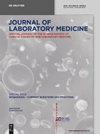Predictive value of combined serum IL-6 with UREA on severity of neonatal pneumonia: an observational study
IF 1.8
4区 医学
Q4 MEDICAL LABORATORY TECHNOLOGY
引用次数: 0
Abstract
Abstract Objectives IL-6 is an inflammatory marker and urea nitrogen (UREA) is a common indicator of glomerular filtration function. Their combined detection has predictive value for the severity of neonatal pneumonia. Methods We performed a cross-sectional analysis of the clinical and laboratory data, collected from 105 neonatal patients (including 76 mild to moderate pneumonia patients and 29 severe pneumonia patients). Results Mann–Whitney U-test showed serum IL-6 and UREA levels were significantly increased in severe pneumonia, compared with that in mild to moderate pneumonia (p<0.05). Correlation analysis showed the severity of neonatal pneumonia was positively correlated with serum IL-6 (r=0.284, p<0.05) and UREA (r=0.303, p<0.05) levels. Multivariate logistic regression analysis showed the increased levels of IL-6 (OR=1.002, 95 % CI 1.001–1.004) and UREA (OR=1.420, 95 % CI 1.046–1.926) were independent risk factors for the severity of neonatal pneumonia. ROC curve analysis showed that the predictive value of combined detection of serum IL-6 and UREA in the severity of neonatal pneumonia was better than that of either detection alone (area under curve [AUC] = 0.809, 95 % CI 0.711–0.894, p<0.001). Conclusions Combined detection of IL-6 and UREA had a good predictive value for evaluating the severity of neonatal pneumonia.血清IL-6与尿素联合检测对新生儿肺炎严重程度的预测价值:一项观察性研究
目的IL-6是炎症标志物,尿素氮(urea)是肾小球滤过功能的常用指标。它们的联合检测对新生儿肺炎的严重程度有预测价值。方法对105例新生儿患者(包括76例轻中度肺炎患者和29例重症肺炎患者)的临床和实验室资料进行横断面分析。结果Mann-Whitney u检验显示,重症肺炎患者血清IL-6和尿素水平明显高于轻、中度肺炎患者(p < 0.05)。相关性分析显示,新生儿肺炎严重程度与血清IL-6 (r=0.284, p < 0.05)、尿素(r=0.303, p < 0.05)水平呈正相关。多因素logistic回归分析显示,IL-6水平升高(OR=1.002, 95% CI 1.001 ~ 1.004)和尿素水平升高(OR=1.420, 95% CI 1.046 ~ 1.926)是新生儿肺炎严重程度的独立危险因素。ROC曲线分析显示,联合检测血清IL-6和尿素对新生儿肺炎严重程度的预测价值优于单独检测两者(曲线下面积[AUC] = 0.809, 95% CI = 0.711-0.894, p<0.001)。结论IL-6与尿素联合检测对评价新生儿肺炎严重程度有较好的预测价值。
本文章由计算机程序翻译,如有差异,请以英文原文为准。
求助全文
约1分钟内获得全文
求助全文
来源期刊

Journal of Laboratory Medicine
Mathematics-Discrete Mathematics and Combinatorics
CiteScore
2.50
自引率
0.00%
发文量
39
审稿时长
10 weeks
期刊介绍:
The Journal of Laboratory Medicine (JLM) is a bi-monthly published journal that reports on the latest developments in laboratory medicine. Particular focus is placed on the diagnostic aspects of the clinical laboratory, although technical, regulatory, and educational topics are equally covered. The Journal specializes in the publication of high-standard, competent and timely review articles on clinical, methodological and pathogenic aspects of modern laboratory diagnostics. These reviews are critically reviewed by expert reviewers and JLM’s Associate Editors who are specialists in the various subdisciplines of laboratory medicine. In addition, JLM publishes original research articles, case reports, point/counterpoint articles and letters to the editor, all of which are peer reviewed by at least two experts in the field.
 求助内容:
求助内容: 应助结果提醒方式:
应助结果提醒方式:


